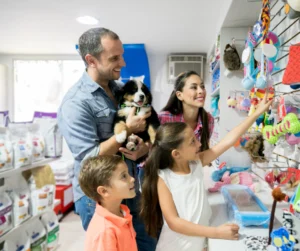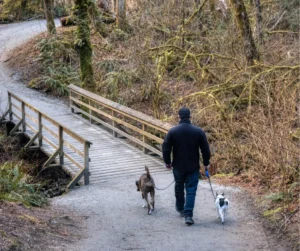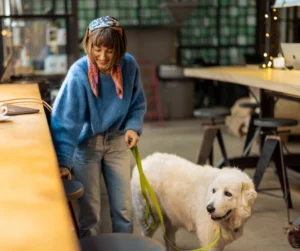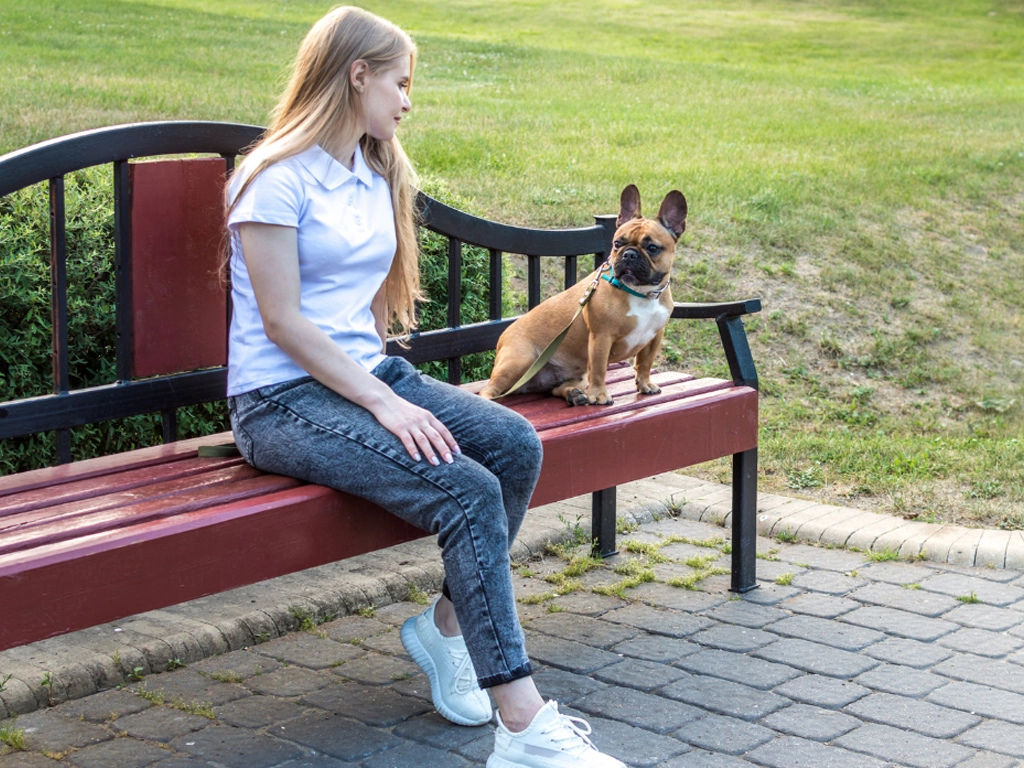Introduction
Dog socialization is a pivotal aspect of canine development, crucial for ensuring a well-adjusted, confident pet in the city of Hamilton and surrounding areas. In a previous article, we approached the subject of what does it mean to socialize a dog and what to look out for. This article delves into various dog socialization techniques, with a focus on passive socialization methods, an often-overlooked method of socialization.
Hanging Out at the Park for Dog Socialization:
Taking your dog to local parks in Hamilton is an excellent strategy for passive socialization. This method involves finding a peaceful area within the park where your dog can comfortably observe their surroundings without direct interaction. Here’s how to expand on this technique:
- Choose the Right Time and Place: Select a time when the park is not overly crowded. Early mornings or late afternoons during weekdays are often ideal. Look for a spot that’s somewhat secluded but still allows your dog to see people, other dogs, and activities from a distance.
- Prepare for the Outing: Bring along your dog’s favourite treats, a water bowl, and a comfortable mat or blanket for them to sit or lie on. Ensure your dog is on a leash for their safety and the safety of others.
- Settle In and Observe: Once you find a suitable spot, allow your dog to settle down. Let them watch the world go by, observing people walking, children playing, cyclists, and other dogs. The goal is for your dog to become accustomed to these sights and sounds without feeling the need to interact directly.
- Reward Calm Behaviour: Whenever your dog remains calm and focused on you despite the distractions, reward them with treats or praise. This reinforces positive behaviour and helps them understand that observing from a distance is a good thing.
- Gradually Reduce the Distance: Over time, as your dog becomes more comfortable with the environment, you can slowly move closer to the paths or areas where people and dogs are more active. Always monitor your dog’s body language to ensure they are not feeling stressed or overwhelmed.
- Practice Basic Commands: Use this time to practice basic obedience commands like ‘sit’, ‘stay’, and ‘look at me’. This not only reinforces training but also helps keep your dog’s focus on you amidst distractions.
- Duration and Frequency: Start with shorter sessions, around 15-20 minutes, and gradually increase the duration as your dog becomes more comfortable up to 60 minutes or longer. Regular visits, a few times a week, can significantly aid in their socialization process.
By incorporating these detailed steps into your routine, you’ll be providing your dog with a rich and varied socialization experience. This method is a gentle and effective way to introduce your dog to the world, helping them develop into well-adjusted, confident pets. This method could also be applied to your front lawn and just sitting with your dog and watching the world go by. Grab a book and the next thing you know; 45 minutes has gone by.
Coffee Shop Vibes: Socialization in Public Spaces

Socializing your dog in the lively atmosphere of a coffee shop in Hamilton can be an enriching experience for them. This method involves taking your dog to an outdoor café and allowing them to observe and absorb the environment. Here’s how to enhance this socialization technique:
- Select the Right Café: Choose a dog-friendly café with outdoor seating. Look for a spot that’s not too crowded but still offers a variety of stimuli, such as people walking by, other dogs in the vicinity, and the general buzz of a café.
- Prepare for the Visit: Bring essentials like water for your dog, their favourite treats, and a comfortable mat or blanket for them to sit on. Ensure your dog is on a leash for their safety and the comfort of other patrons.
- Settle Comfortably: Find a spot where you can comfortably sit with your dog. Allow them to settle down and get used to the new environment. It’s important that they feel secure and relaxed in this setting.
- Observe and Absorb: Let your dog watch the activities around the café. The goal is for them to become accustomed to the sights and sounds of a busy public space without feeling the need to interact directly.
- Reward and Reinforce: Reward your dog for calm and focused behaviour. Treats, praise, or gentle petting can reinforce their good behaviour in a bustling environment.
- Practice Training Commands: Utilise this opportunity to practice basic obedience commands with your dog. Commands like ‘sit’, ‘stay’, and ‘down’ can help keep your dog engaged and focused on you, despite the distractions.
- Gradual Exposure: Start with short visits and gradually increase the duration as your dog becomes more comfortable. Regular visits can significantly aid in their socialization and adaptability to public spaces.
- Monitor Your Dog’s Comfort Level: Always be attentive to your dog’s body language and signs of stress or anxiety. If they seem overwhelmed, it may be best to leave and try again another day.
Incorporating ‘Coffee Shop Vibes’ into your dog’s socialization routine offers a unique opportunity to expose them to the dynamics of urban life in a controlled manner. This method not only helps your dog get used to being around people and other dogs in a public setting but also reinforces their training in a real-world environment. It’s a practical way to integrate socialization into your daily life, making it a regular and enjoyable part of your routine with your dog.
Quiet Walks: Exploring Hamilton and Caledonia’s Tranquil Routes

Quiet walks are an essential part of dog socialization, especially for dogs that may feel overwhelmed in busy environments. This method involves choosing less crowded, more peaceful routes for your walks, allowing your dog to gradually acclimatize to different surroundings. Here’s how to expand on this technique:
- Selecting the Right Path: Research and identify tranquil walking routes in Hamilton or along the Grand River in Caledonia that are less frequented by people and other dogs. Ideal locations might include quiet neighbourhood streets, secluded paths in parks, or nature trails. The goal is to find environments that are calming yet offer new experiences for your dog.
- Preparing for the Walk: Ensure you have everything you need for a stress-free walk. This includes a suitable leash and harness, water for both you and your dog, and some treats for positive reinforcement. Also, consider bringing along a toy or a chew to help your dog relax during breaks.
- Gradual Introduction: Start with short walks in these quieter areas. Observe how your dog reacts to different stimuli such as birds, passing cars, or distant pedestrians. Gradually increase the duration and complexity of the walks as your dog becomes more comfortable.
- Focus on Positive Experiences: Use these walks as an opportunity to bond with your dog and reinforce positive behaviour. Reward them for calmness and obedience. If they react nervously to a particular stimulus, calmly redirect their attention and offer reassurance.
- Incorporate Training: Quiet walks are an excellent opportunity to practice basic obedience commands in a low-distraction environment. Commands like ‘heel’, ‘sit’, and ‘stay’ can be reinforced during the walk.
- Monitor Your Dog’s Reactions: Pay close attention to your dog’s body language. If they show signs of stress or fear, it’s important to acknowledge these feelings and not push them too far out of their comfort zone.
- Build Up to Busier Environments: As your dog grows more confident, gradually introduce them to busier areas. This could include walking at times when there are more people around or choosing slightly busier routes. The key is to make this transition gradual and comfortable for your dog.
Quiet walks are a gentle and effective way to socialize your dog, particularly for those who may find busy environments overwhelming. You can help your dog build confidence and learn to navigate different settings calmly and confidently.
Pet-Friendly Stores: Socialization in Retail Environments
Socializing your dog in pet-friendly stores is a fantastic way to introduce them to a variety of new experiences in a controlled environment. This method involves taking your dog to retail settings where they can encounter different sights, sounds, and smells. Here’s how to expand on this technique:
- Choose the Right Store: Start by identifying pet-friendly stores in Hamilton that are suitable for your dog’s socialization. These could include pet supply stores, outdoor gear shops, or any retail space that welcomes dogs. The key is to find a store with a calm atmosphere but enough activity to provide a new experience for your dog.
- Prepare for the Visit: Before heading out, ensure your dog is well-exercised and has had a chance to relieve themselves. Bring along their favourite treats, a water bottle, and a portable bowl. Make sure your dog is wearing a comfortable harness or collar and is securely leashed.
- Entering the Store: As you approach the store, observe your dog’s body language. If they seem relaxed, proceed inside. If they appear hesitant, spend a few minutes outside the store allowing them to observe from a distance before entering.
- Inside the Store: Keep your dog close to you and on a short leash to maintain control. Allow them to explore the environment at their own pace, sniffing and observing their surroundings. Be mindful of other customers and pets in the store.
- Reward Calm Behaviour: Reinforce positive behaviour by rewarding your dog for remaining calm and focused. Treats and verbal praise can help your dog associate the store environment with positive experiences.
- Practice Obedience Commands: Use this opportunity to practice basic commands like ‘sit’, ‘stay’, and ‘heel’. This not only reinforces training but also helps keep your dog’s focus on you in a new environment.
- Monitor and Adjust: Pay close attention to your dog’s reactions. If they show signs of stress or discomfort, it may be best to shorten the visit and try again another day. Gradually increase the duration of the visits as your dog becomes more comfortable.
- Seek Professional Guidance: If you’re unsure how to proceed in this environment or if your dog shows signs of anxiety, consider taking private lessons from us. K9 Principles can provide expert guidance and support to make your pet-friendly store visits a success.
Visiting pet-friendly stores is an excellent way to socialize your dog in a unique and stimulating environment. By following these expanded steps, you can help your dog become accustomed to different retail settings, enhancing their overall socialization and adaptability.
Controlled Playdates: Safe Social Interactions

Controlled playdates are an integral part of a dog’s social as long as these interactions are done in a safe, structured, and positive manner. Here’s how to expand on this technique:
- Selecting Compatible Playmates: The key to a successful playdate is choosing the right dogs to interact with. We recommend selecting dogs that are known to be calm, friendly, and have a similar play style and energy level to your dog. This compatibility is crucial for fostering positive interactions and ensuring a safe play environment.
- Choosing an Appropriate Venue: The location of the playdate should be a secure, enclosed space where dogs can interact freely without the risk of escape. This could be a private garden, a secure dog park, or a designated indoor play area. The chosen venue should be neutral territory to avoid territorial behaviour.
- Structured Introductions: Introduce the dogs in a controlled manner, initially on leashes, to gauge their reactions to each other. Observe their body language closely for signs of comfort or distress. A proper introduction sets the tone for the playdate and helps in preventing conflicts.
- Active Supervision: Throughout the playdate, active supervision is essential. Our expert trainers at K9 Principles can provide guidance on how to read canine body language and signals to ensure that play remains friendly and non-aggressive. It’s important to intervene if play escalates or if any dog shows signs of stress.
- Managing Playtime Duration: Keeping play sessions short and controlled, especially initially, is important to prevent overstimulation and fatigue. Gradually increasing the duration of playdates as the dogs become more comfortable with each other is recommended.
- Concluding Positively: Ending the playdate while the dogs are still engaged and enjoying themselves ensures that the experience remains a positive one. Rewarding the dogs for good behaviour reinforces positive social interactions.
Travel Adventures: Socialization on the Go
Acclimatize your dog to travel by taking them on short car rides or using public transport, if feasible. This exposure is crucial for dogs living in urban areas like Hamilton, as it helps them adapt to various modes of transportation. Let’s dive in to how we can successfully do this:
- Gradual Introduction to Travel: Begin by introducing your dog to the vehicle in a non-threatening way. Allow them to explore the car while it’s stationary, offering treats and praise to create a positive association. Short, pleasant trips around the neighbourhood can be a good starting point.
- Creating a Comfortable Environment: Ensure your dog has a safe and comfortable space in the vehicle. Use a dog seatbelt, crate, or carrier to secure them during the journey. Bring along their favourite blanket or toy to provide a sense of familiarity and comfort.
- Familiarization with Public Transport: If you plan to use public transport, start by familiarizing your dog with the sounds and sights of buses or trains from a distance. Gradually bring them closer to the transport during less busy times to reduce stress and anxiety.
- Positive Reinforcement: Throughout the public transportation travel experience, use positive reinforcement to reward calm and relaxed behaviour. Treats, praise, and gentle petting can help your dog associate travel with positive experiences.
- Short and Frequent Trips: Initially, opt for short and frequent trips to build your dog’s confidence. Gradually increase the duration and complexity of the journeys as they become more comfortable.
- Monitoring and Adjusting: Pay close attention to your dog’s reactions during travel. If they show signs of stress or discomfort, it’s important to take a step back and reduce the intensity of the exposure. Patience and gradual progression are key.
Travel socialization is a crucial aspect of a dog’s overall development and should not be ignored.
FAQs
-
A1. Dog socialization involves exposing your dog to various environments, people, animals, and situations to help them become well-adjusted, confident, and comfortable in different settings. It’s important because it reduces fear and anxiety in dogs, prevents behavioural problems, and helps them develop into well-behaved pets.
Conclusion
Effective dog socialization involves a combination of different techniques and environments. By following these detailed steps, you can ensure your dog becomes a well-socialized, confident, and happy companion. Whether you’re interested in group classes or private training in Hamilton, K9 Principles is here to support you every step of the way. Our experienced trainers are committed to providing the best dog training in Hamilton, tailored to your dog’s unique needs. Contact us today to start your dog’s socialization journey.
- Name: K9 Principles
- Address: Haldimand County, Greater Hamilton Area, Burlington and Most of Norfolk County
- Phone: 289 880-3382
- Email: k9principlesinc@gmail.com
- Website: www.k9principles.ca



